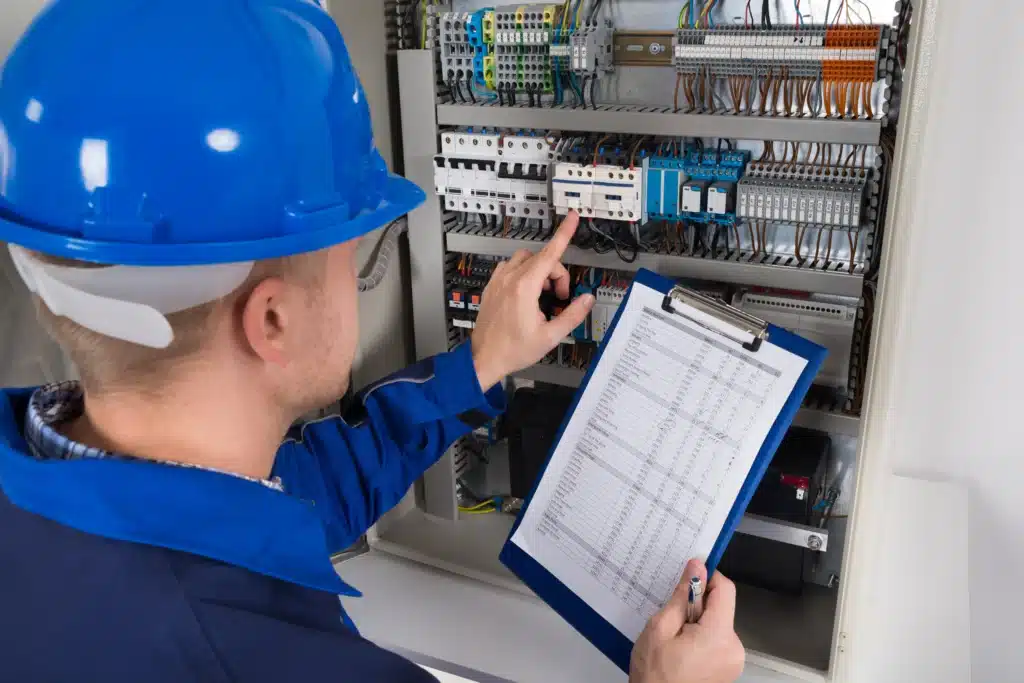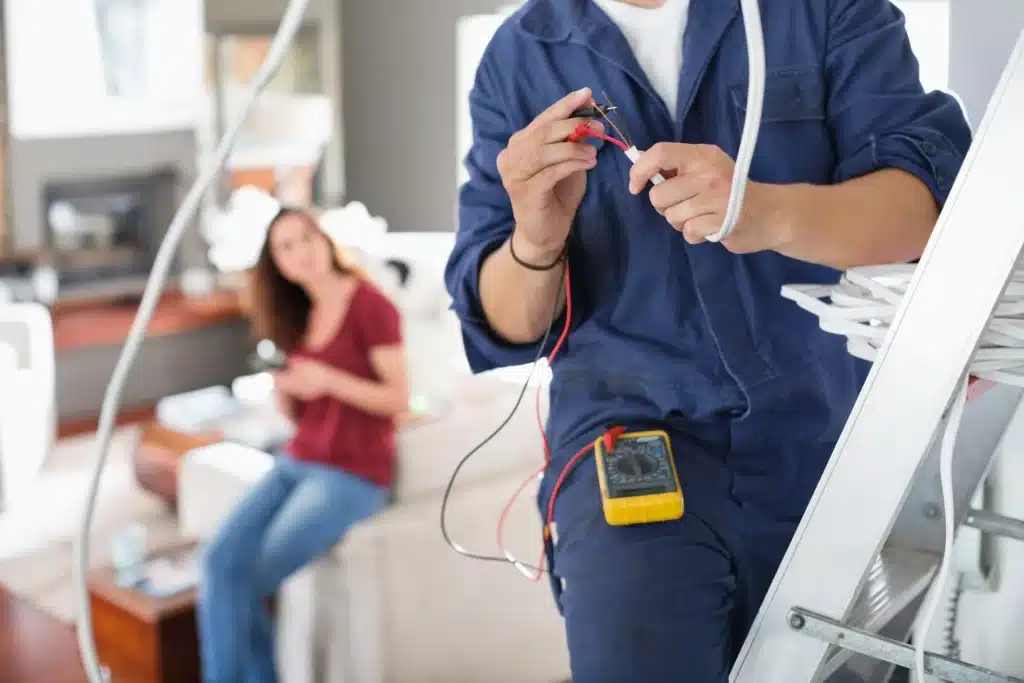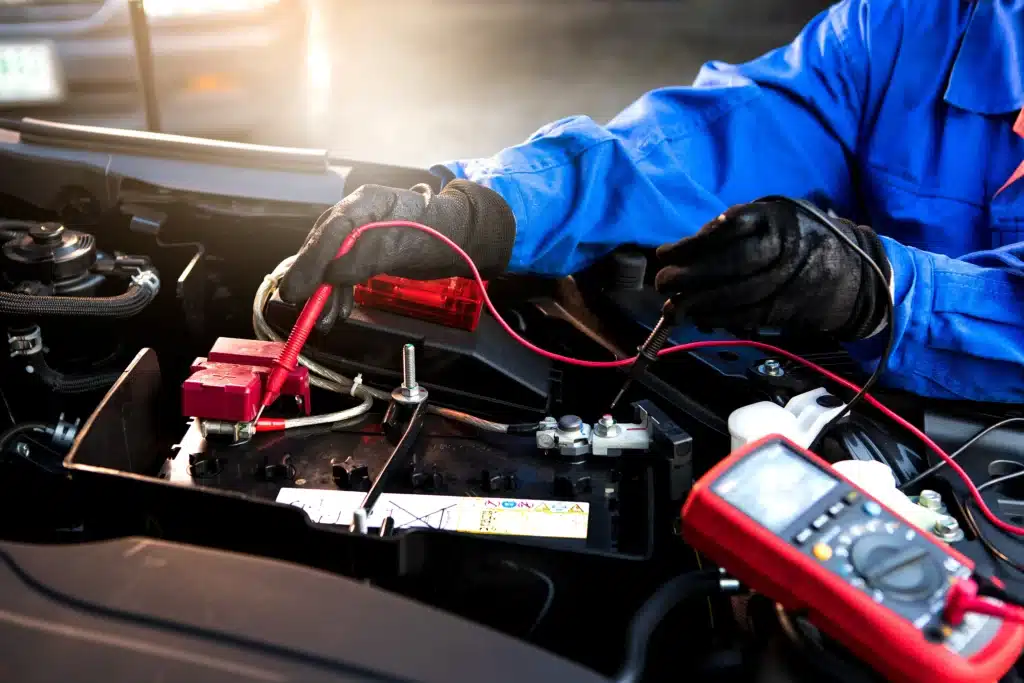
For an electrical contractor, finding the time and know-how to market their businesses effectively is a constant struggle. If you find yourself wondering how to attract more customers and promote your services, you’re certainly not alone.
This guide is dedicated to teaching you to navigate the world of digital marketing for electricians. Dive deep with us as we uncover why mastering digital marketing is no longer optional but a cornerstone for success, explore the unique marketing challenges that an electrician like you faces daily, and unveil electrical contractor marketing ideas that are specifically designed to take advantage of the skills you offer.
Let’s dive in!
Table of Contents
- Word of Mouth Marketing vs Digital Marketing?
- Electrician Marketing is Hard. Here’s Why.
- 6 Strategies for Electrician Marketing
- Key Takeaways
Word of Mouth Marketing vs Digital Marketing?
Word of mouth marketing, the oldest form of getting business, operates on the principle of reputation and customer recommendations. Inviting an electrician into your home requires trust, which makes home services as a whole an excellent candidate for WOM.
Social media marketing campaigns, search engine optimization, and pay per click advertising are just some of the digital marketing strategies that dominate the marketing world. But a well-known Nielsen report proved that despite it all, 92% of consumers trust recommendations from friends and family over any other form of advertising.
This is because no advertisement and replicate “social proof”, the psychological phenomenon where individuals do as others do in order to choose the correct behavior for a given situation. When the people you trust recommend a service, it’s seen as a vetted, safe choice that reduces risk. In his book Contagious: How to Build Word of Mouth in the Digital Age, Jonah Berger writes:
“Word of mouth is more effective than traditional advertising for two key reasons. First, it’s more persuasive. Second, word of mouth is more targeted. It is naturally directed towards an interested audience. But want to know the best thing about word of mouth? It’s available to everyone. And it doesn’t require millions of dollars spent on advertising. It just requires getting people to talk.”
Is One Better Than the Other in 2024?
Digital marketing isn’t what it was a few years ago. Today, AI and machine learning allow business owners to scale their digital marketing strategy faster than ever before, with almost half of all marketers using AI to generate content. But that doesn’t mean marketing has gotten simpler, especially for small business owners who might not have the time or money to spend learning the newest online tools or hiring a digital marketing agency. If you’re a solo electrician, you’re probably already spread thin.
As mentioned earlier, word of mouth marketing has the unique benefit of being extraordinarily potent AND inexpensive. Personal connections with your existing customer base builds loyalty, meaning you can expect repeat customers over time. However, word of mouth marketing is much slower than the potentially instantaneous effects of digital marketing strategies like paid ads via Google Local Service Ads. If time is of the essence, relying exclusively on referrals is unlikely to lead to exciting results.
It seems that whether one is better than the other is purely dependent on how much time and money you have to spend. If you can afford to buy and learn the tools, then digital marketing can offer fast, effective results. But if you don’t have the money or free time to spend on so much extra marketing, doing a great job that earns you referrals will still act as a form of advertising. A combination of both (such as lots of good reviews on your Google Business Profile, formerly Google My Business) can be a great blend of digital and traditional.
Electrician Marketing is Hard. Here’s Why.
Marketing in the electrical service industry is uniquely challenging. Your electrical company offers essential services that, paradoxically, many people don’t think about until they absolutely need them. This reactive approach to hiring electricians, the general lack of awareness about the necessity for regular electrical maintenance, and stiff competition from other service providers create a complex marketing landscape. Here’s a closer look at each challenge within electrician digital marketing:

Electrical Work is (Usually) a Distress Purchase
Traditionally, people think of electrical contracting services as fixes for an emergency problem; these are are a type of distress purchase. A distress purchase is a purchase a consumer didn’t expect to (and often resents) having to make; around 70% of these in the tech industry involve replacing something broken.
Relying on distress purchases can make it extremely difficult to have a consistent stream of income, and make planning your business just as difficult. When you can’t forecast your earnings, you can’t figure out how much should go to marketing vs other expenses like gas, vehicle maintenance, and how much you can afford to take home.
Plus, when you’re working with a potential customer having an emergency, you’re looking at a double-edged sword. You might think that in an emergency, potential clients are willing to pay whatever it takes to get their issue resolved quickly. But in reality, most electrical emergencies are more of a severe inconvenience than a threat to anyone’s safety. This puts them in a great position to use Google Search to shop around very quickly for other electricians, which might pressure you into lowering your rates.
Preventative Maintenance is a Hard Sell
Many electrical issues don’t show symptoms until it gets too late, making preventative maintenance difficult to market. Without any obvious problems, home and business owners might not feel like they need your services as an electrical contractor. The benefits of hiring you, in those cases, would be preventative: You would be helping them avoid a safety hazard later, or forego a repair that might become more expensive later down the line. Convincing someone of a problem they can’t see, or haven’t even experienced yet, is a huge challenge. And the science is on your skeptical customers’ side: IBM research shows that only 10% of asset failures occur at random, not because the asset has reached a certain age.
Preventative maintenance services include things like:
- Electrical system inspections
- Installation of surge protectors
- Updating and maintenance of lighting systems
- Testing and replacing smoke detectors and carbon monoxide detectors
- Checking and tightening electrical connections
- Performing energy usage audits

Often, Marketing Becomes a ‘Race to the Bottom’
Many electricians struggle to explain what makes their services unique compared to their competitors. After all, if it can be expected that all parties involved would do a good job, what USP (unique selling point) remains but a low cost to fight over? This situation creates a ‘race to the bottom’, where profit margins get slimmer and customers struggle to find a reason to prioritize much else, so long as the problem they are facing gets solved.
With slimming profit margins, finding time to develop a marketing strategy becomes a lot more of a risk when that same time could be spent taking additional jobs. But without marketing, your brand recognition is based entirely on hoping customers remember your name and tell their friends…and that’s if their friends turn to them instead a search engine!
Have you ever had a customer say to you, “I found someone who can do it cheaper, can you match their price?” only for you to feel the urge to either cave and cut your profit margins, or risk the sale by trying to convince them of your value? This puts both you and the customer in an awkward position.
6 Strategies for Electrician Marketing
Electrician marketing can have some unique challenges, but it’s far from impossible. It’s well-worth your time to develop a marketing strategy for your electrician business.
Here are 6 ways you can do that.
1. Create Goals for Your Business
“It’s really important to find accountability when you start [goal-setting]; not halfway through, not towards the end when you’re struggling. At the very beginning.”
– Business Coach Josh Horneman on The Electricians’ Success Podcast
Set clear, well-defined goals for your electrician business. Start by figuring out where you currently stand; conduct a thorough SWOT analysis to identify your business’s strengths, weaknesses, opportunities, and threats. Some of the things you should pay especially close attention to are your technical skills, how good you are at providing quality customer service, how efficient you tend to be while working as an electrical contractor, and where you stand in the market compared to the other electricians in your area.
Now that you know where you stand compared to the competition, it’s time to come up with some goals; for example, add an additional service offering or increase your Facebook follower count through targeted social media campaigns. No matter what goals you set, they should always (in some way) benefit customer satisfaction.
Good goal example: Get a minimum average rating of 4.5 stars on Yelp within the next six months.
Bad goal example: Get as many Facebook followers as possible.
Make sure you’re keeping track of how effective these are using some kind of a metric or KPI (key performance indicator). You might track followers on social media, your average rating on Yelp, or the number of monthly visitors to your website. Don’t obsess over the numbers, but make sure you’re reviewing them regularly so that you can change your electrician marketing strategy quickly if something doesn’t seem to be working.
2. Excel at the Job
Excellence in your job significantly boosts the likelihood of customers recommending your services to others. On average, satisfied customers will share their positive experiences with 11 other people, and dissatisfied customers will tell 15 others.
But how do you do even better than you are now? Consider these techniques:
Educate your customers while you work: Teach them why precision in wiring, quality materials, and industry standards are important. Explain to them how your methods won’t just keep them safe, but provide durability over time. Take, for example, the Hoover Dam. The hydroelectric generators and turbines were designed with precision, high-quality materials, and the strictest quality standards. It’s been operating successfully for over 80 years, and continues to be a reliable source of electricity for millions of people every day.
Enhance Customer Service: Demonstrate professionalism—through timely arrivals, appropriate attire, and cleanliness during and after the electrician job. Customers want a seamless experience, and while you can’t control everything in your environment, you can do your best to make their experience an easy one. For instance, adopting an online scheduling system like ours could streamline the process, enhancing overall customer satisfaction by allowing them to book without a call.
Itemize Invoices: Clearly explain all costs, including materials, labor, and any additional fees. Itemized invoices and explaining each charge can mitigate misunderstandings and fortify your customers’ confidence in your abilities. For better financial clarity, drafting a pricing sheet might be beneficial.

3. What Do You Do Better Than Other Electricians? Brag About It!
As we stated earlier, having a USP as an electrician is extremely difficult. After all, you are offering a service that is often seen as a commodity. But there are still ways you can make sure your customers remember who you are.
How do you go above and beyond in ways that other electricians don’t? Do you follow up every job with a satisfaction check, or stay on the cutting-edge of particular niches like sustainable energy? Make sure that that unique offering is echoed through all your electrician advertising, from your logo to your website to a powerful tagline that reminds the world what you’re about. This consistency should extend to your brand colors, your fonts, your website design, and even making sure you’re using the latest version of your logo everywhere you go.
If you have knowledge on any of these niches, consider yourself lucky. Here are some of the electrician specialties particularly in demand right now:
- Solar and wind energy: Do you know how to install, maintain, and/or repair solar panels, wind turbines, and energy storage systems? If so, you might thrive in the booming renewable energy sector.
- Smart grids and smart buildings: If you’re skilled in working with smart grid sensors, controllers, and communication systems, you might be able to find unique work installing and fixing them.
- Electric vehicles: There’s increased demand for electricians that can install and maintain EV charging stations safely and keep up to date on how the newest ones work, and it’s expected that the global EV charging infrastructure market will reach USD 147.94 billion by 2030, 30% up from where it was in 2021.

4. Educate Your Customers
Because many people don’t understand the benefits of electrical maintenance, it’s on you to educate them as to why they need your non-emergency services. For cost-savvy customers, buying more often may benefit them; research indicates that reactive maintenance costs 3-4 times more than preventative maintenance. Not only that, but preventative maintenance overall results in a an average of 545% ROI, an almost unheard of amount.
The best way to do such content marketing is through a mixed approach to marketing effort, where you use a variety of platforms to educate customers:
- Blog Posts: Topics like “The Cost of Neglecting Electrical Maintenance” or “5 Signs Your Electrical System Needs a Check-Up,” teach customers why maintenance matters. Even if most asset failures happen at random, there are still clear signs you can show potential customers that something is starting to fail before it happens, such as flickering lights and unusual noises or smells.
- Social Media: Quick tips, infographics, and short videos that touch on some of the most common problems customers run into. A social media platform is also a great place to do live Q&As where people can ask about their own electrical concerns.
- YouTube: Video marketing is a great way to produce more detailed videos than what you’d post on social media, such as a guide to what happens during a maintenance check or a look around somewhere that narrowly averted an electrical disaster (as long as you have the customer’s permission).
- Email Marketing: Although these are usually used for things like special offers and reminders, you can slip in quick tips here, too.
5. Follow Up
After you finish the job, do a brief yet thorough check-in with the customer a few days post-service. Use this opportunity to send a concise customer satisfaction survey via email. Tailor your questions to not only gauge satisfaction, but also to uncover any unresolved issues. Here are a couple of questions you might ask:
- On a scale of 1-10, how satisfied were you with the overall quality of the work performed?
- Did we arrive on time and communicate effectively throughout the service visit?
- Were you satisfied with the professionalism and cleanliness of the technician?
- Did we take the time to explain the work being done and answer any questions you had?
- Is there anything we could have done to improve your experience?
Additionally, consider adding a customer follow-up program. Through a mix of personalized emails, text messages, or phone calls, you can keep past customers informed and engaged. An automated system can streamline this process, ensuring timely and consistent follow-ups and increase the likelihood that customers remember you and tell their friends when electrical needs come up in conversation.
6. Get Involved
Delve into events that resonate with your brand’s mission. For example, contribute your electrical knowledge to a local school’s science day or sponsor energy-efficient lighting for a community holiday event. Showing that you care about a cause, such as the environment or education, is great for your reputation as a brand. This is particularly impactful in smaller communities, where trust and word-of-mouth are invaluable for reputation management. It also helps build online mentions aka citations, an important facet of local SEO.
If you’re going this route, you need to be genuine. Follow up with contacts made during events, and stay active in local social media groups. You could even offer a discount for those in your surrounding neighborhood. But remember, each community is different, and what matters to one community may not be as impactful in another. For example…
- A neighborhood with a high percentage of elderly residents is more likely to care about safety presentations than green energy.
- A tech-savvy urban area is more likely to be impressed with your knowledge of renewable energy than your sponsorship of their local baseball game.
- An area with a high population of parents and kids is more likely to value your donation to their schools’ STEM programs over your work on energy-efficient buildings.

Key Takeaways
- Combine word of mouth with digital marketing strategies to get the best of both worlds.
- Excel in your service and customer education to increase word-of-mouth referrals.
- Distinguish your services with unique selling points (USPs) to stand out in the competitive market.
- Invest in educating customers on the importance and ROI of preventative maintenance, and they’ll be more likely to book non-emergency services.
- Implement a follow-up strategy to both be remembered and learn what you could do better.
